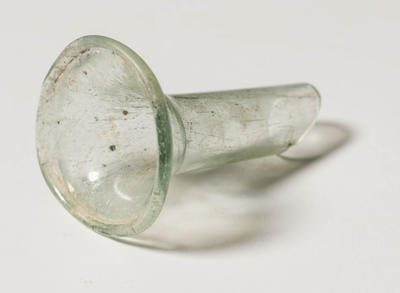Candlestick unguentarium, part of neck and neck and rim
Production date
50 CE-250 CE
100 CE-300 CE
Country
Cyprus
See full details
Object detail
Description
Candlestick unguentarium. Pale blue blown glass. Very low almost flat disc-shaped body with evenly sloping shoulder. Indented base with central concavity. Narrow cylindrical neck narrowing to splaying rim, rounded but not folded and pulled wider and flatter to one side, perhaps to facilitate pouring. Broken at neck, some fragments missing. Some iridescence (Webb, Jennifer M., 1997 "Corpus of Cypriote Antiquities", Studies in Mediterranean Archaeology, Vol. XX:p 20).
Classification
DOMESTIC EQUIPMENT Containers vase
ARCHAEOLOGY Cypriot
ARCHAEOLOGY Cypriot
Production date
50 CE-250 CE
100 CE-300 CE
100 CE-300 CE
Production place
Measurements
Candlestick Di34
Base H14 x D72
Base H14 x D72
Media/Materials description
Glass
History and use
An 'unguentarium' is a small bottle used to hold ointments, perfumes, balms and other liquids for use in the toilet (bathroom). These were used by both men and women, the contents applied after waking and after bathing. Popular scents included saffron, marjoram and rose. The material inside the glass may be debris, or fine remnants of the original content. These tall, cylindrical forms are known as 'candlestick' unguentarium, as they sometimes resemble early candlesticks. They may have a flat or round base, the neck may taper, and be with or without a constriction at the top of the neck, thought to allow for easier pouring of the precious contents. The glass is especially thin and fine.
Associated person
Registration number
H684.2




